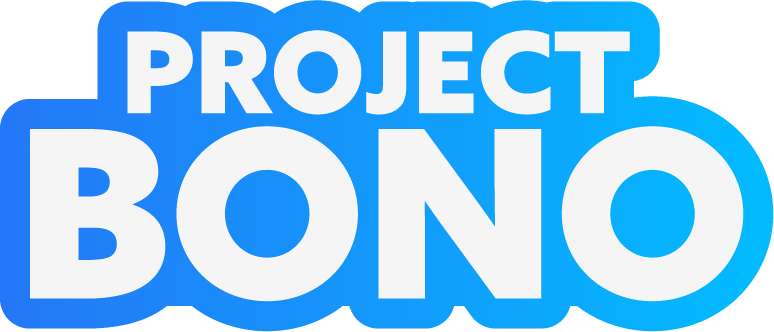
Enriching Communities Through Substance Abuse Education
Discover how Project Bono is fighting substance abuse and promoting public health in communities nationwide.
Introduction
Educating community members on the risks and consequences associated with drug and alcohol use is a crucial aspect of maintaining public health that should not just be prioritized after an incident, but as a part of formative learning. The detrimental effects of substance abuse on individuals, families, and communities have been well documented, and early detection and intervention are essential in preventing addiction and minimizing the associated costs.
One effective approach to achieve this goal is by offering accessible substance abuse education programs such as Project Bono, which aim to equip people of all ages and backgrounds with the knowledge and tools they need to make informed choices and avoid potentially harmful situations now and in the future to protect themselves and their community.
Table of Contents
Introduction
Substance Abuse and Public Health
The Risks of Underage Alcohol Consumption
What Assigning Project Bono Means for Your Community
Substance Abuse and Public Health
Substance abuse is a major public health concern in the United States. According to the Substance Abuse and Mental Health Services Administration (SAMHSA), roughly 85.6% of adults in the United States have used alcohol at some point in their lives and according to the Centers for Disease Control and Prevention, substance misuse is the leading cause of preventable death in the United States, with over 95,000 Americans dying each year from drug overdoses, and an even greater number of 140,000 people dying from alcohol-related causes annually.
The Risks of Underage Alcohol Consumption
Underage alcohol use can have serious and long-term consequences. There are countless negative effects that alcohol can have on overall health and well-being. Persistent alcohol use can increase the risk of developing chronic conditions such as liver disease, cancer, and mental health disorders. Using alcohol while underage can also lead to poor academic performance, an increased chance of engaging in risky behaviors such as unprotected sex and violence, and even death as a result of accidents such as motor-vehicle accidents, homicide, and suicide. Alcohol causes nearly 5,000 deaths annually among young people.
What Assigning Project Bono Means for Your Community
Project Bono's goal is to provide people of all ages with accurate information about the risks and consequences of drug and alcohol use, as well as the advantages of living a healthy lifestyle. Furthermore, Project Bono works to engage the community in the substance abuse education process by fostering greater understanding, strengthening partnerships, and redirecting 25% of proceeds to back to the communities that direct offender to our programs and accept our certificates of completion.
Project Bono's philanthropic value proposition of contributing 25% of enrollment proceeds back to the communities that assign our programs can open the door to enrichment opportunities like investing in schools and preventing recidivism by funding necessary recovery programs, community service efforts, and other initiatives. By providing funding for such programs, Project Bono can offer much-needed support to individuals who have been impacted by the criminal justice system and addiction.
Additionally, by investing in schools and education programs, Project Bono aims to prevent at-risk individuals from entering the criminal justice system in the first place. This approach not only helps to improve the lives of individuals and communities, but it also relieves burdens on taxpayers by reducing the costs associated with incarceration and reoffending. Overall, Project Bono's community reinvestment initiative can be a life-changing opportunity for communities nationwide, create positive change, and promote social justice through targeted investments in education and recovery programs.
Project Bono's philanthropic value proposition of contributing 25% of enrollment proceeds back to the communities that assign our programs can open the door to enrichment opportunities like investing in schools and preventing recidivism by funding necessary recovery programs, community service efforts, and other initiatives. By providing funding for such programs, Project Bono can offer much-needed support to individuals who have been impacted by the criminal justice system and addiction.
Additionally, by investing in schools and education programs, Project Bono aims to prevent at-risk individuals from entering the criminal justice system in the first place. This approach not only helps to improve the lives of individuals and communities, but it also relieves burdens on taxpayers by reducing the costs associated with incarceration and reoffending. Overall, Project Bono's community reinvestment initiative can be a life-changing opportunity for communities nationwide, create positive change, and promote social justice through targeted investments in education and recovery programs.
Sources
Substance Abuse and Mental Health Services Administration (SAMHSA). 2019 National Survey on Drug Use and Health (NSDUH). Table 2.1B—Tobacco Product and Alcohol Use in Lifetime, Past Year, and Past Month among Persons Aged 12 or Older, by Age Group: Percentages, 2018 and 2019. https://www.samhsa.gov/data/sites/default/files/reports/rpt29394/NSDUHDetailedTabs2019/NSDUHDetTabsSec t2pe2019.htm#tab2-1b Accessed 01/27/23.
Centers for Disease Control and Prevention (CDC). Alcohol and Public Health: Alcohol-Related Disease Impact (ARDI). Annual Average for United States 2011–2015 Alcohol-Attributable Deaths Due to Excessive Alcohol Use, All Ages. Available at: https://nccd.cdc.gov/DPH_ARDI/Default/Default.aspx. Accessed 01/27/23
Centers for Disease Control and Prevention. Centers for Disease Control and Prevention, Deaths from Excessive Alcohol Use in the United States. 6 July 2022, https://www.cdc.gov/alcohol/features/excessive-alcohol-deaths.html. Accessed 01/27/23
National Institute on Alcohol Abuse and Alcoholism, U.S. Department of Health and Human Services. Underage Drinking. https://pubs.niaaa.nih.gov/publications/AA67/AA67.htm. Accessed 01/27/23
Centers for Disease Control and Prevention (CDC). Alcohol and Public Health: Alcohol-Related Disease Impact (ARDI). Annual Average for United States 2011–2015 Alcohol-Attributable Deaths Due to Excessive Alcohol Use, All Ages. Available at: https://nccd.cdc.gov/DPH_ARDI/Default/Default.aspx. Accessed 01/27/23
Centers for Disease Control and Prevention. Centers for Disease Control and Prevention, Deaths from Excessive Alcohol Use in the United States. 6 July 2022, https://www.cdc.gov/alcohol/features/excessive-alcohol-deaths.html. Accessed 01/27/23
National Institute on Alcohol Abuse and Alcoholism, U.S. Department of Health and Human Services. Underage Drinking. https://pubs.niaaa.nih.gov/publications/AA67/AA67.htm. Accessed 01/27/23
Page last updated: January 27, 2023
OUR COURSES
Drag to resize

Project Bono provides the most affordable up-to-date online classes that fulfill court and employer mandates while contributing 25% of proceeds towards charitable causes.
SOCIAL LINKS
RESOURCES
-
About Us
-
Print a Referral
-
Example Certificate
-
Where We're Accepted
Drag to resize
SUPPORT
Drag to resize


Copyright © 2024 Project Bono. All Rights Reserved
Money-Back Guarantee
All of our courses are backed by a 30-day money-back guarantee. If your certificate of completion is not accepted, contact us with proof of decline.
We recommend you confirm that your assigner will accept our certificates before you enroll in any of our courses.
Note: Cryptocurrency payments do not qualify at this time.
We recommend you confirm that your assigner will accept our certificates before you enroll in any of our courses.
Note: Cryptocurrency payments do not qualify at this time.
Drugs & Alcohol
MIP
Anger
Truancy
Cannabis
Bullying
Theft
Nicotine
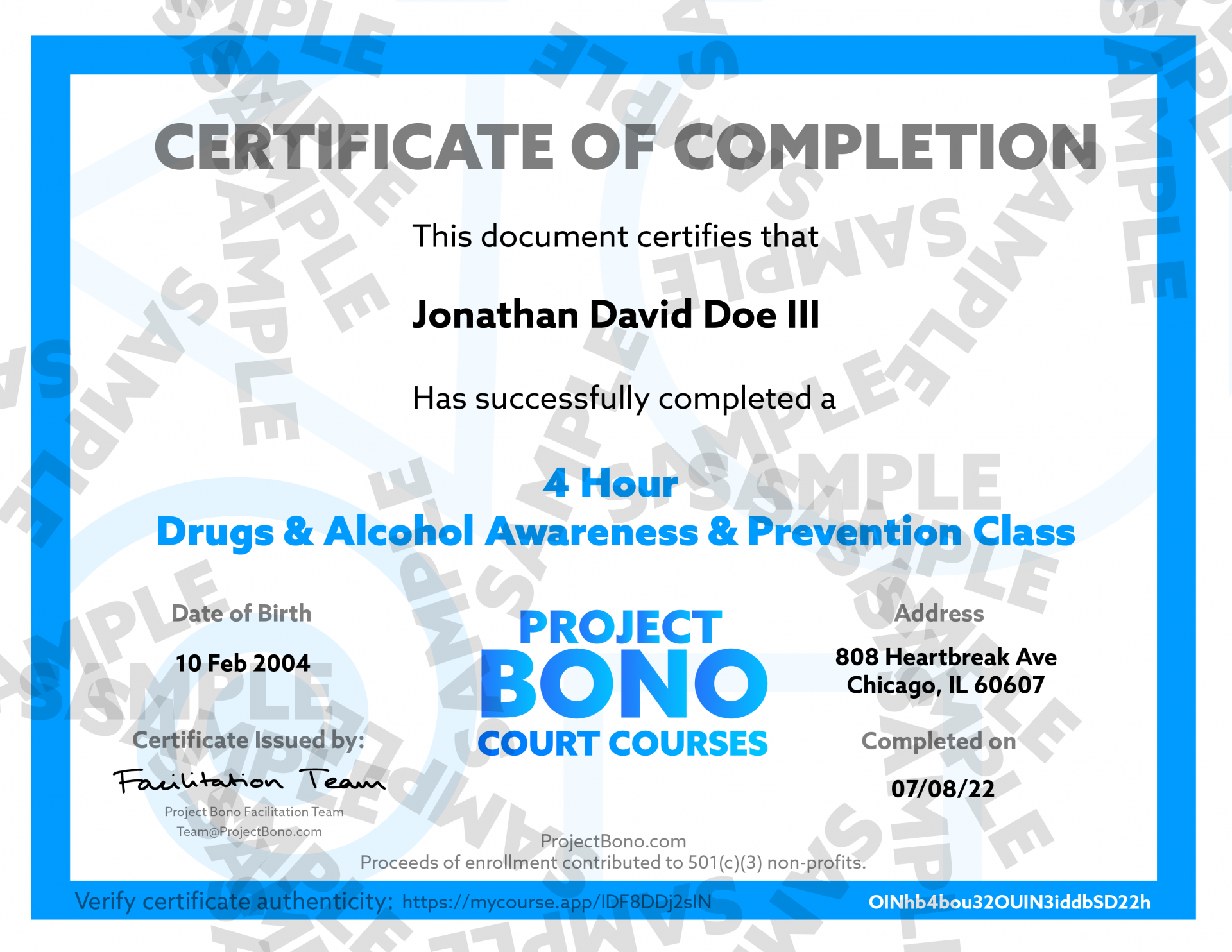
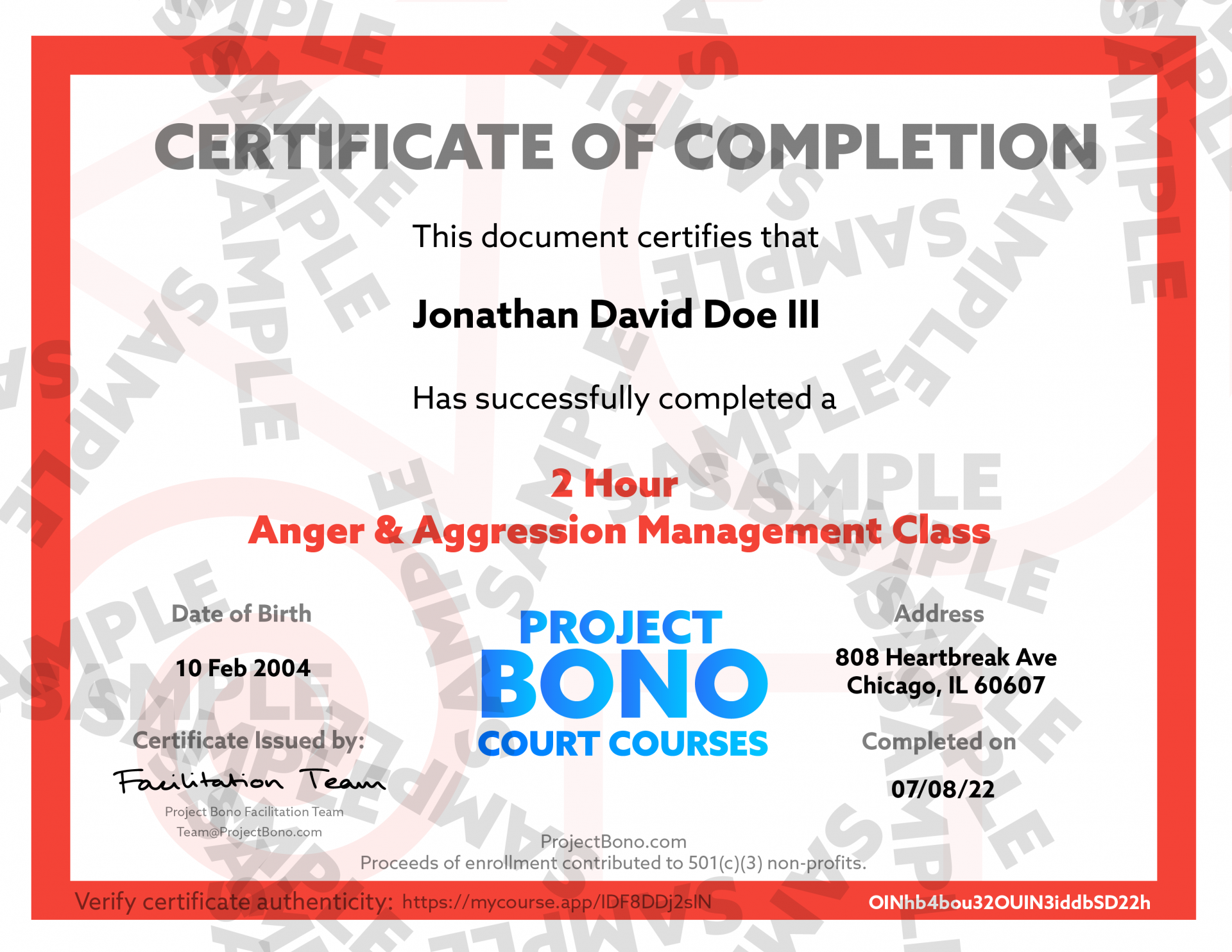
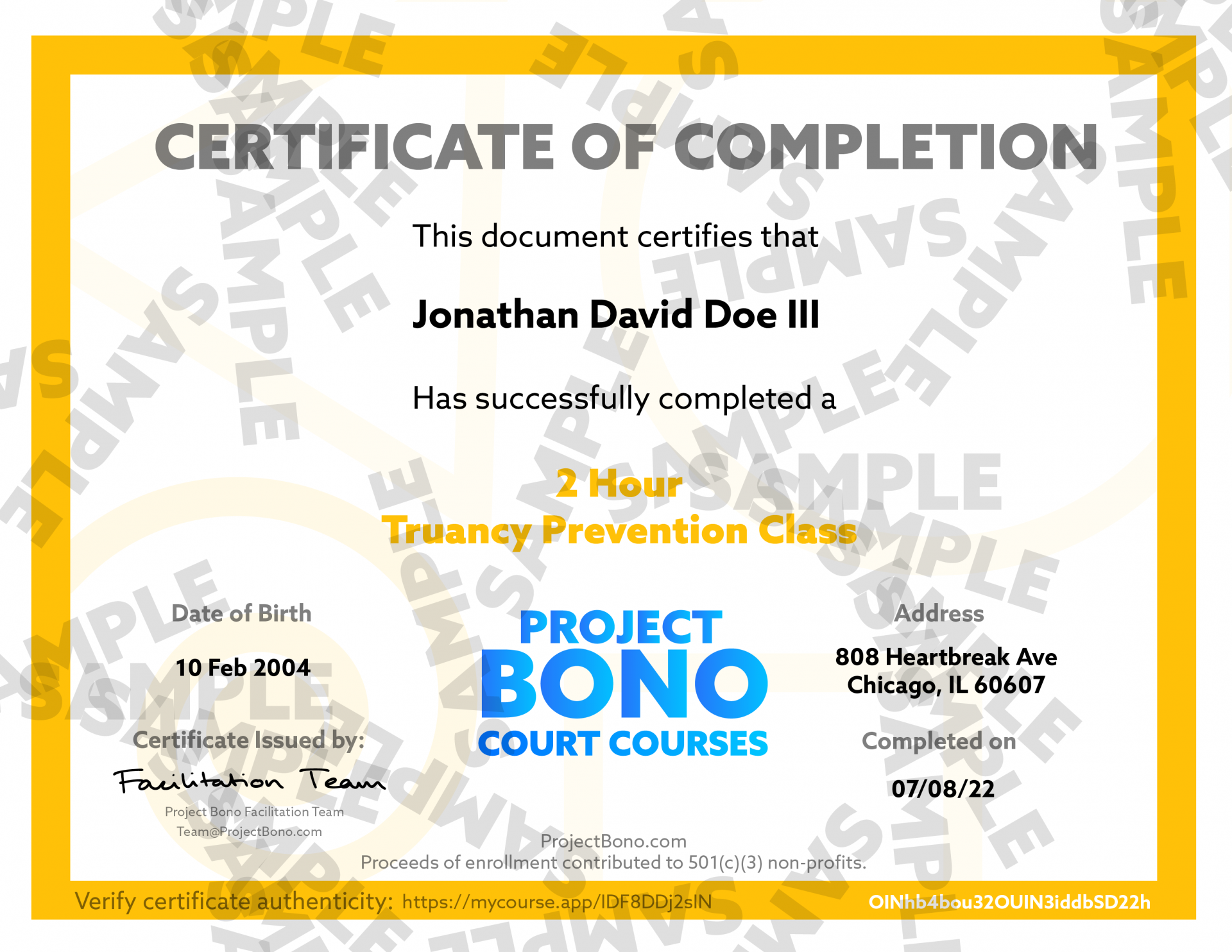
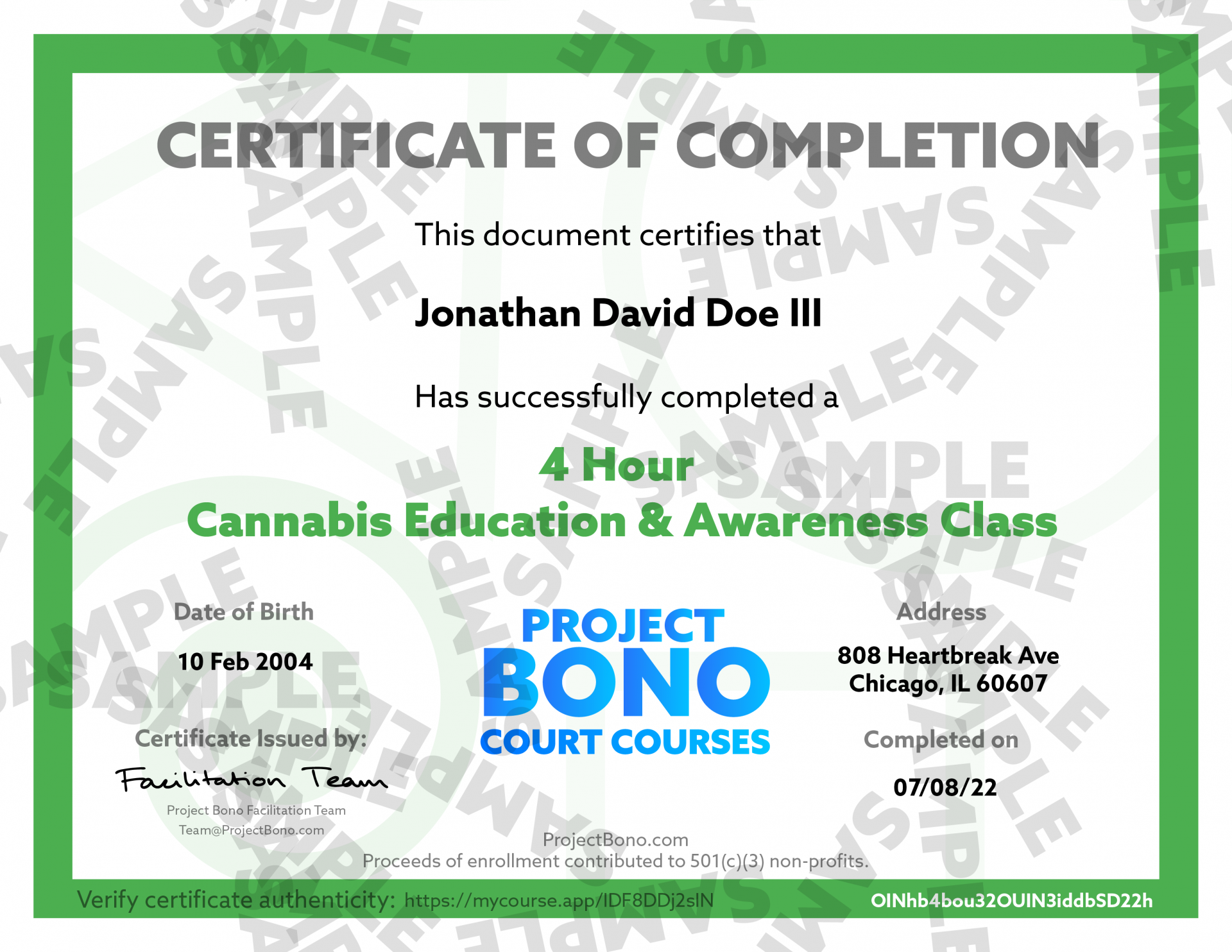
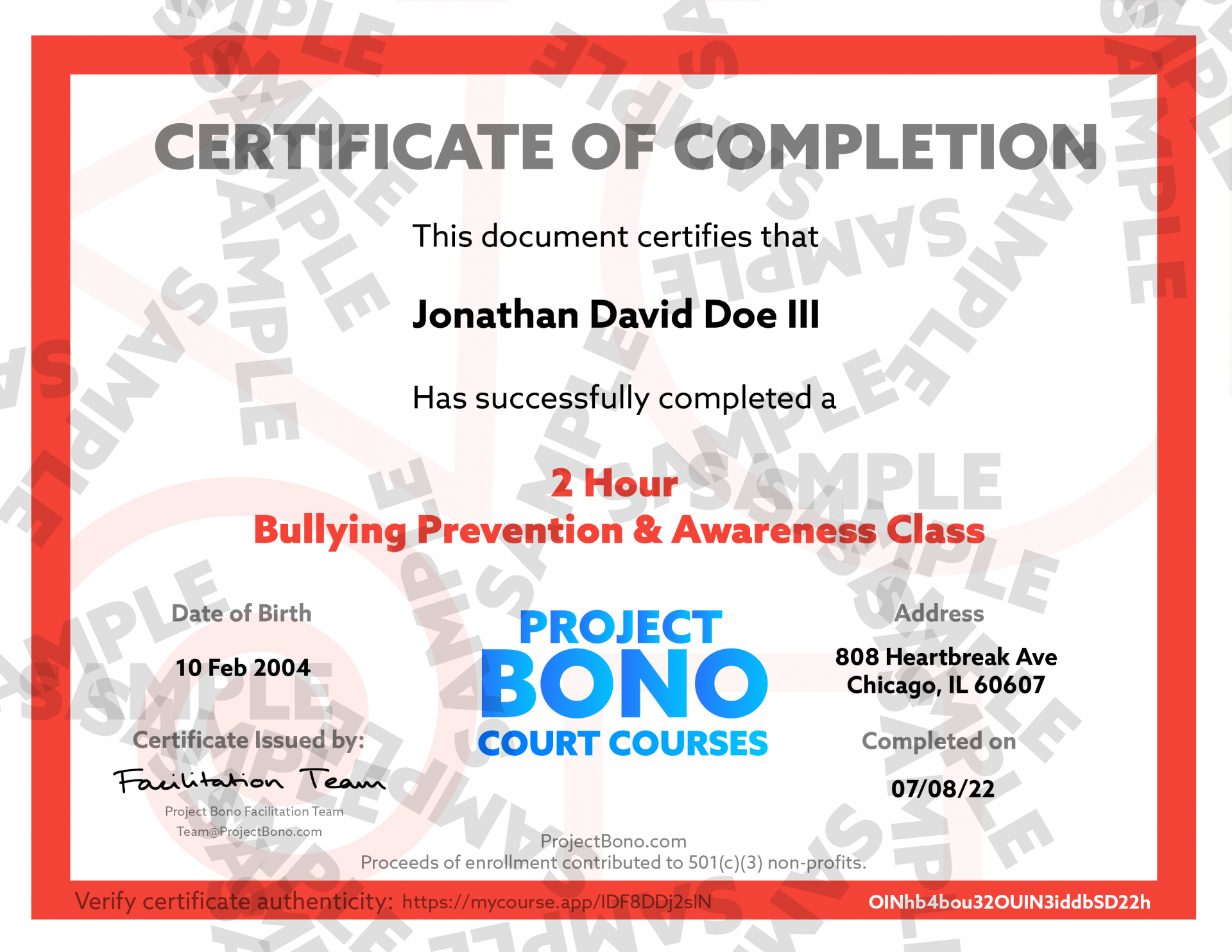
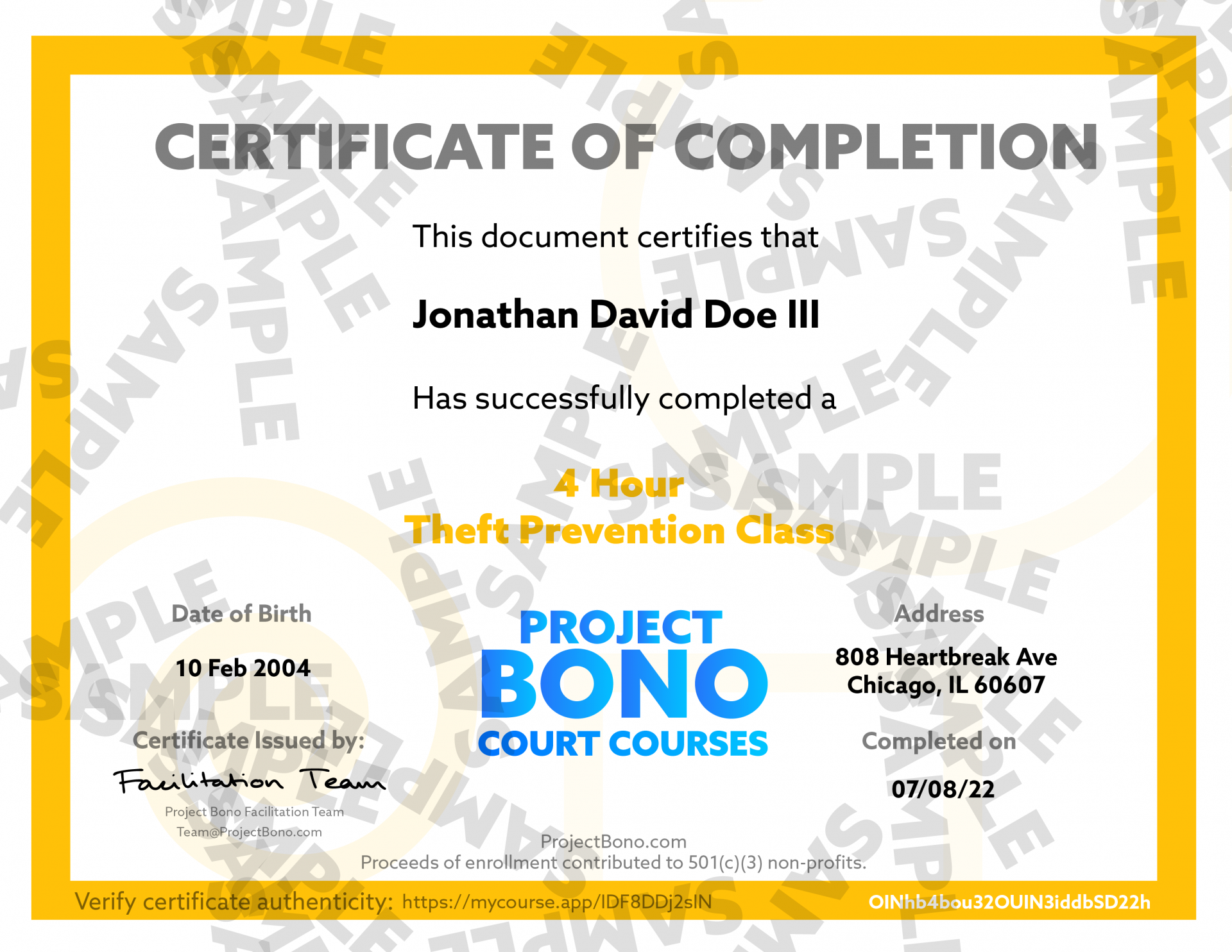
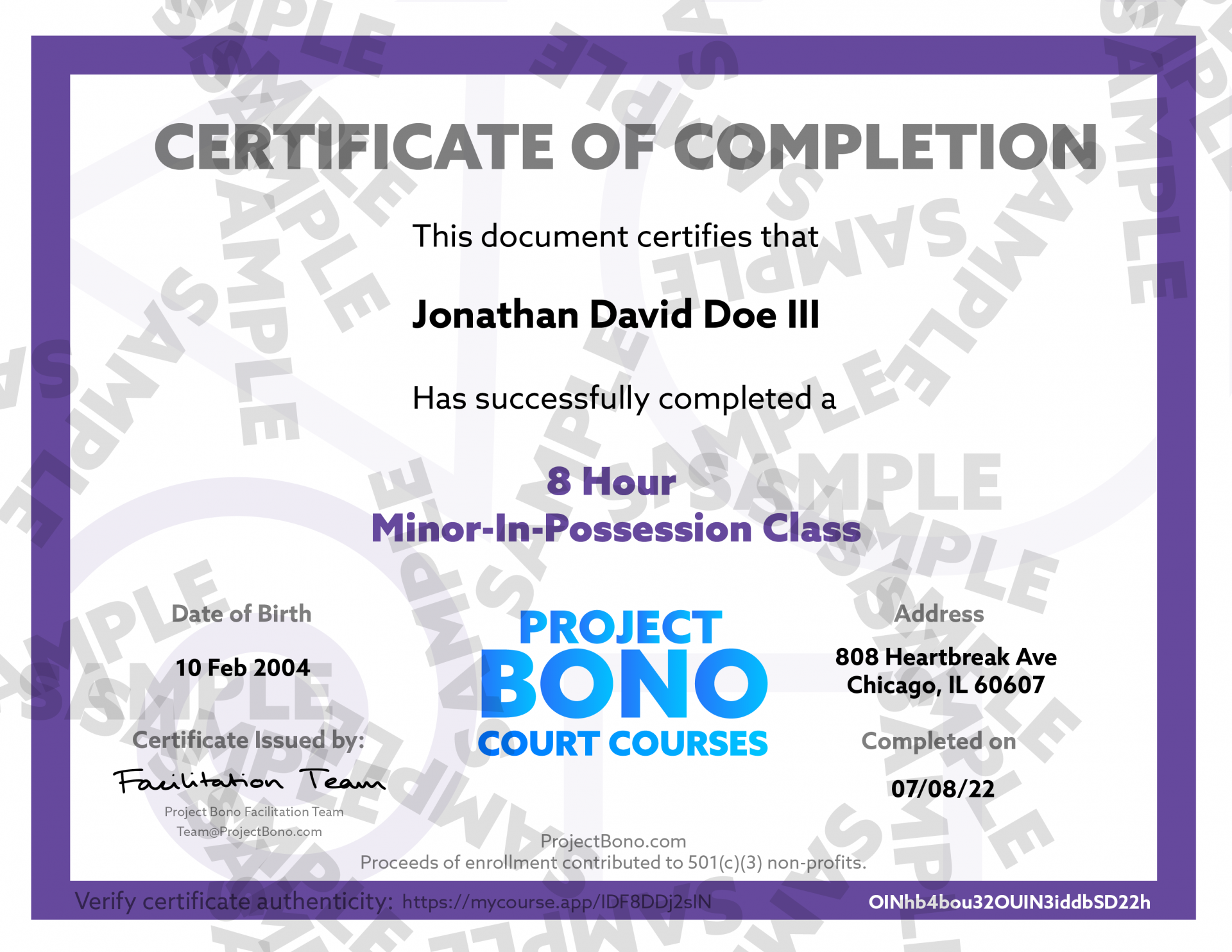
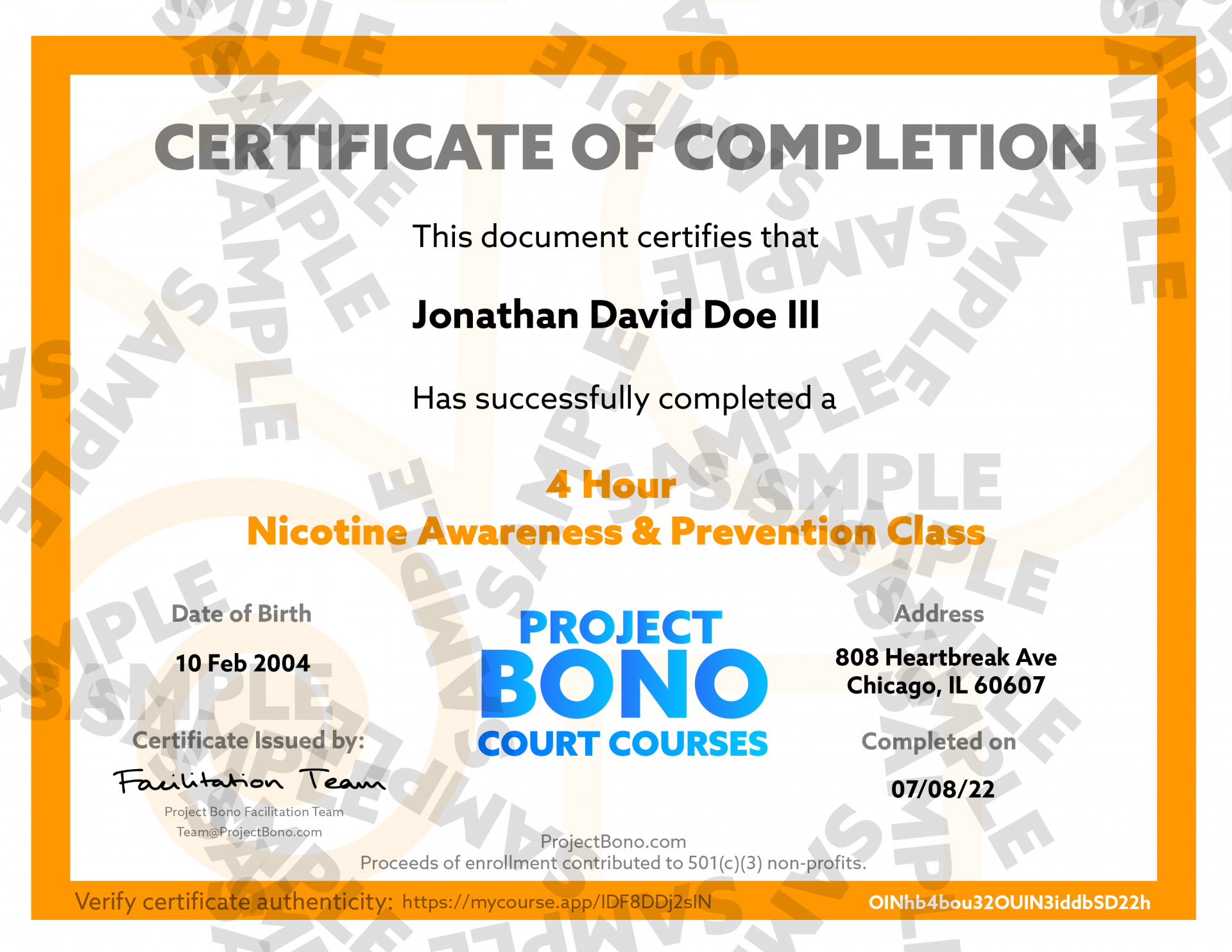
Course updates
Course contents and formatting are subject to improvements.
We are constantly monitoring current scientific and legislative data to provide you with the most accurate information within our courses. When you purchase any of our courses you are entitled to all future versions of the course.
We are constantly monitoring current scientific and legislative data to provide you with the most accurate information within our courses. When you purchase any of our courses you are entitled to all future versions of the course.
PrintableHandouts
Download and print PDF handouts to easily direct students to the correct course and start assigning!
How does Project Bono work?
Project Bono offers correctional education programs that aim to educate first-time and repeat offenders about the risks associated with substance abuse and harmful behaviors.
As you progress through our courses, you'll have access to various forms of media, including videos, to help you understand the material.
Once you've completed the course and met the time requirement, you'll receive a certificate of completion that you can share with your court, school, or employer.
As you progress through our courses, you'll have access to various forms of media, including videos, to help you understand the material.
Once you've completed the course and met the time requirement, you'll receive a certificate of completion that you can share with your court, school, or employer.
One thing that makes Project Bono stand out is that we donate 25% of enrollment proceeds back to the communities that assign our programs.
This means that by assigning our programs, not only are individuals learning valuable life skills and building awareness, but they are also enriching the communities that assign our programs.
This means that by assigning our programs, not only are individuals learning valuable life skills and building awareness, but they are also enriching the communities that assign our programs.
What Programs are offered?
We cover a wide range of topics including Drugs & Alcohol Awareness, Cannabis Education, Minor in Possession (MIP), Nicotine Prevention, Bullying Prevention, Anger Management, Theft Prevention, Truancy Prevention, and more.
We continuously update our programs to reflect current research and trends in substance abuse and other harmful behaviors.
Forgot your Password?
If you forgot your password, you can reset it by clicking on the "Forgot your password?" link on the login page.
If you signed up with an existing social account and the "Forgot your password?" solution doesn't work, you may need to change your password on the existing social account.
If you signed up with an existing social account and the "Forgot your password?" solution doesn't work, you may need to change your password on the existing social account.
Can I take a course on my phone?
Yes!
All of our courses are accessible across any device with a web browser.
All of our courses are accessible across any device with a web browser.
Can I take a course on my phone?
Project Bono is accessible to anyone with a web browser (such as Google Chrome, Safari, Microsoft Edge, etc.), and a stable internet connection. Whether you choose to participate from a desktop computer, laptop, tablet, or smartphone, you should be able to access our programs with ease.
Our website is designed to adjust to your device's screen size and resolution, making it easy to start a course on one device and pick up where you left off on another. If you have any questions about the technology required to participate in our programs, our support team is always here to help.
Our website is designed to adjust to your device's screen size and resolution, making it easy to start a course on one device and pick up where you left off on another. If you have any questions about the technology required to participate in our programs, our support team is always here to help.
What if my certificate is not accepted?
If your certificate of completion is not accepted by a member of the court, counselor, employer, administrator, or any other occupational, educational, or legal assigner, please contact us.
Our certificates come backed with a 30-day acceptance guarantee. If your certificate is not accepted for any reason, please provide us with documented proof of rejection, such as an email or written statement from the assigner.
We always recommend contacting your issuing party before purchasing any of our courses to confirm they will accept your certificate. Please note that refunds in these cases are only granted within the 30-day guarantee period.
How do I request a refund?
If you need to request a refund for any reason, including if your certificate of completion is not accepted by your assignor, you can do so by sending us an email at team@projectbono.com.
To enact our acceptance guarantee, please include in your email a written proof of decline from the assignor that includes a way of reaching them. If the request is within 30 days of your purchase and meets the criteria of our acceptance guarantee, we will process your refund promptly.
Please note that refunds that don't qualify for the acceptance guarantee, such as those requested outside of the 30-day window or for reasons other than non-acceptance by your assignor, are reviewed and issued on a case-by-case basis.
If you have any questions or concerns about requesting a refund, please don't hesitate to contact our customer support team at team@projectbono.com.
Am I able to pause the course?
Yes, participants are able to pause the course and continue at any time, on any device. Our platform is designed to save your progress consistently while you participate in the course, so you can pick up right where you left off. Whether you need to take a break for a few hours or a few days, you can rest assured that your progress will be saved.
We want you to get the most out of our courses and achieve your goals, and that means being able to learn at your own pace and on your own schedule. So go ahead and take a break if you need to - we'll be here when you're ready to continue.
How long does it take to complete a course?
The time it takes to complete a course varies depending on the time requirement you choose. When you enroll in a course, the time requirement will be clearly stated on the course page, along with an estimated completion time based on that requirement.
If you're unsure about which time requirement to choose or have any other questions about course completion time, you should reach out to your assigning party.
What does the certificate look like?
Every certificate generated by Project Bono includes the following information: course title and time requirement, student's name, birth date, address, date of completion, and certificate verification link. This information is unique to each certificate and cannot be duplicated or edited.
We offer certificates in PDF format because it's the most efficient way to send documents over email, while also reducing paper, ink, energy, transportation, and overall costs required to mail a physical copy.
Remember, it's important to submit your certificate of completion to your assignor as soon as possible to avoid any complications. If you have any questions or issues, please contact our support team for assistance.
Hollup.
Who are You?
Acceptance Guarantee
Enhance your assurance with our 30-Day Acceptance Guarantee.
Whenever you enroll in a Project Bono program, you have the peace of mind knowing that our certificate is backed by our Acceptance Guarantee. If your certificate isn't embraced by the assigning entity, we've got you covered.
Simply provide us with a proof of decline, and we'll handle the rest.
Simply provide us with a proof of decline, and we'll handle the rest.
◊ Acceptance Guarantee: Offer is only valid for 30 days from the date of certificate issuance and is available to participants within the U.S. The guarantee is subject to validation of the proof of non-acceptance provided by the enrollee. For detailed information regarding our policy, see support.projectbono.com/acceptance-guarantee.